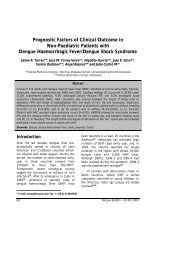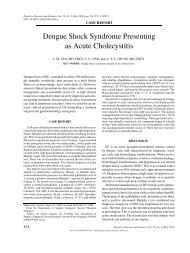Role of the endothelium in viral hemorrhagic fevers - Benh Vien ...
Role of the endothelium in viral hemorrhagic fevers - Benh Vien ...
Role of the endothelium in viral hemorrhagic fevers - Benh Vien ...
Create successful ePaper yourself
Turn your PDF publications into a flip-book with our unique Google optimized e-Paper software.
esponse. Most <strong>of</strong> <strong>the</strong>se diseases are worst<br />
while <strong>the</strong> virus is actively replicat<strong>in</strong>g <strong>in</strong> <strong>the</strong><br />
organs and released to circulate <strong>in</strong> <strong>the</strong><br />
blood. Only <strong>in</strong> <strong>the</strong> hantavirus diseases and<br />
<strong>in</strong> dengue HF does <strong>the</strong> classic, virusspecific<br />
immune response seem to play a<br />
role <strong>in</strong> caus<strong>in</strong>g <strong>the</strong> cl<strong>in</strong>ical manifestations,<br />
and <strong>in</strong> those diseases, immunopathology is<br />
an important part <strong>of</strong> <strong>the</strong> disease process.<br />
In <strong>the</strong> case <strong>of</strong> dengue virus, <strong>in</strong> <strong>the</strong> overwhelm<strong>in</strong>g<br />
majority <strong>of</strong> cases, HF follows sequential<br />
<strong>in</strong>fections with different serotypes;<br />
it is not <strong>in</strong>cluded <strong>in</strong> Table 1 because it is not<br />
one <strong>of</strong> <strong>the</strong> primary VHFs. There is now<br />
considerable <strong>in</strong>formation that suggests that<br />
immune enhancement and immunopathology<br />
are <strong>the</strong> major factors <strong>in</strong> <strong>the</strong> genesis<br />
<strong>of</strong> this syndrome, which is primarily a vascular<br />
permeability disease.<br />
ARENAVIRUSES<br />
Figure 1. Top, patient with <strong>hemorrhagic</strong> fever with renal syndrome show<strong>in</strong>g subconjunctival hemorrhage<br />
<strong>of</strong> <strong>the</strong> bulbar conjunctivae and vascular congestion <strong>of</strong> <strong>the</strong> palpebral conjunctivae. Bottom,<br />
patient with Bolivian <strong>hemorrhagic</strong> fever, a South American arenavirus <strong>hemorrhagic</strong> fever, with diffuse<br />
mucosal bleed<strong>in</strong>g. Reproduced with permission from Peters et al (1).<br />
Table 1. Viral <strong>hemorrhagic</strong> <strong>fevers</strong><br />
Arenaviridae Lassa fever and South American<br />
HF (Argent<strong>in</strong>e, Bolivian, etc.)<br />
Bunyaviridae<br />
Phlebovirus Rift Valley fever<br />
Nairovirus Crimean Congo HF<br />
Hantavirus HF with renal syndrome and<br />
Hantavirus pulmonary<br />
syndrome<br />
Filovirus Marburg HF and Ebola HF<br />
Flavivirus Yellow fever, KFD, and Omsk<br />
HF<br />
HF, <strong>hemorrhagic</strong> fever; KFD, Kyasanur Forest<br />
disease.<br />
differs, and <strong>the</strong> ways <strong>in</strong> which <strong>the</strong> viruses<br />
<strong>in</strong>teract with cells are similarly different<br />
(Tables 2 and 3).<br />
PATHOGENESIS OF HF<br />
Some <strong>of</strong> <strong>the</strong>se viruses cause almost no<br />
cytopathic effects, whereas o<strong>the</strong>rs are<br />
highly destructive to <strong>the</strong> cells <strong>the</strong>y <strong>in</strong>fect.<br />
Pro-<strong>in</strong>flammatory cytok<strong>in</strong>e <strong>in</strong>duction (particularly<br />
tumor necrosis factor [TNF]-), <strong>in</strong><br />
cases <strong>in</strong> which it has been measured, is a<br />
general f<strong>in</strong>d<strong>in</strong>g. Dissem<strong>in</strong>ated <strong>in</strong>travascular<br />
coagulation (DIC) occurs <strong>in</strong> some but<br />
Crit Care Med 2002 Vol. 30, No. 5 (Suppl.)<br />
Table 2. Similarities among <strong>hemorrhagic</strong> fever<br />
viruses<br />
Similarities<br />
Vascular syndrome<br />
Dysregulation<br />
Increased permeability<br />
Diffuse damage<br />
Small RNA viruses, 1–2 10 6 d<br />
Lipid envelope<br />
Aerosol <strong>in</strong>fectivity<br />
Persist <strong>in</strong> nature <strong>in</strong>dependently <strong>of</strong> humans<br />
Table 3. Differences among <strong>hemorrhagic</strong> fever<br />
viruses<br />
Differences<br />
Replication strategy<br />
Virion structure and morphogenesis<br />
Cytopathic effects <strong>in</strong> mammalian cells<br />
Sensitivity to anti<strong>viral</strong> effects <strong>of</strong> <strong>in</strong>terferon<br />
Pathogenesis <strong>of</strong> <strong>in</strong>fection<br />
Human immune response<br />
Survival strategy <strong>in</strong> nature<br />
not <strong>in</strong> o<strong>the</strong>rs. Involvement <strong>of</strong> <strong>the</strong> liver also<br />
varies. HF is a s<strong>in</strong>gle syndrome but not a<br />
stereotypical disease (3, 5).<br />
One <strong>of</strong> <strong>the</strong> important pathogenetic differences<br />
<strong>in</strong>volves <strong>the</strong> role <strong>of</strong> <strong>the</strong> immune<br />
The arenaviruses, which cause Lassa<br />
fever <strong>in</strong> Africa and Argent<strong>in</strong>e and Bolivian<br />
HF <strong>in</strong> South America, are particularly<br />
<strong>in</strong>terest<strong>in</strong>g; fur<strong>the</strong>rmore, arenavirus <strong>in</strong>fections<br />
occur reasonably frequently <strong>in</strong><br />
predictable sites, provid<strong>in</strong>g a pool <strong>of</strong> patients<br />
for study. Throat swabs from patients<br />
demonstrate a small amount <strong>of</strong> virus,<br />
but titers are low and <strong>in</strong>constant.<br />
Person-to-person transmission is not<br />
very high, except possibly through sexual<br />
<strong>in</strong>tercourse <strong>in</strong> convalescence, but patients<br />
develop effusions quite regularly.<br />
High-titered virus is present <strong>in</strong> <strong>the</strong><br />
Lassa fever effusion. Arenavirus <strong>in</strong>fection<br />
<strong>of</strong> <strong>the</strong> meso<strong>the</strong>lial cells on <strong>the</strong> surface <strong>of</strong><br />
<strong>the</strong> organs ba<strong>the</strong>d <strong>in</strong> <strong>the</strong> effusion suggests<br />
a direct effect <strong>of</strong> <strong>the</strong> <strong>in</strong>fection on <strong>the</strong><br />
exudation <strong>of</strong> fluid (5). Figure 2 shows <strong>the</strong><br />
pleural surface <strong>of</strong> a patient with Lassa<br />
fever. The meso<strong>the</strong>lium is very <strong>in</strong>tensely<br />
sta<strong>in</strong>ed for <strong>viral</strong> antigen. Arenaviruses<br />
also <strong>in</strong>fect <strong>the</strong> capillary endo<strong>the</strong>lium <strong>of</strong><br />
many organs <strong>in</strong> <strong>the</strong> body.<br />
The arenaviruses are not highly cytopathic,<br />
and thus, it is not clear what<br />
mechanism is <strong>in</strong>volved <strong>in</strong> <strong>the</strong> alteration<br />
<strong>of</strong> vascular endo<strong>the</strong>lial function or how<br />
much <strong>of</strong> <strong>the</strong> functional change is caused<br />
by direct <strong>in</strong>fection and how much is from<br />
<strong>the</strong> cytok<strong>in</strong>e activation that is evident <strong>in</strong><br />
<strong>the</strong> arena<strong>viral</strong> HF. Pro-<strong>in</strong>flammatory cytok<strong>in</strong>es<br />
are elevated, and <strong>in</strong> Argent<strong>in</strong>e<br />
HF, <strong>the</strong>re is a correlation between mortality<br />
and <strong>the</strong> levels <strong>of</strong> TNF- and <strong>in</strong>terferon<br />
(IFN) (6–8). Arenavirus <strong>in</strong>fection<br />
has also been shown to cause a loss <strong>of</strong><br />
cellular function—such as growth hormone<br />
secretion <strong>in</strong> <strong>the</strong> mur<strong>in</strong>e pituitary<br />
or neurohumoral transmitter secretion<br />
S269




